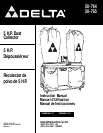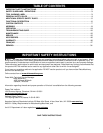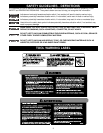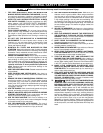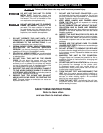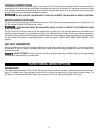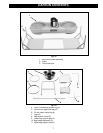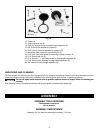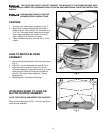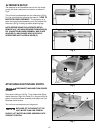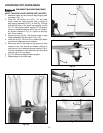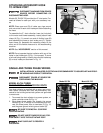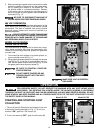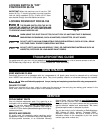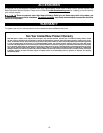
6
POWER CONNECTIONS
A separate electrical circuit should be used for your machine. This circuit should not be less than #12 wire and should be
protected with a 30 Amp time lag fuse. Before connecting the machine to the power line, make sure the electric current
is of the same characteristics as indicated on the machine's specification plate. All line connections should make good
contact. Running on low voltage will damage the machine.
DO NOT EXPOSE THE MACHINE TO RAIN OR OPERATE THE MACHINE IN DAMP LOCATIONS.
MOTOR SPECIFICATIONS
The 50-764 is wired for 230 volts, 60HZ alternating current. The 50-764 can also be reconfigured to run on 460 volts. The
50-765 is wired for 230V, 60 HZ alternating current.
THIS MACHINE MUST BE GROUNDED WHILE IN USE TO PROTECT THE OPERATOR FROM
ELECTRIC SHOCK.
The 50-764 and 50-765 dust collectors are not supplied with a power cord. They must be permanently connected to the
building’s electrical system and grounded according to the National Electrical Code. Since they must be permanently
connected to the building’s electrical system, extension cords cannot be used with these dust collectors. For instructions
on how to wire three phase or single phase motors, check the section “SINGLE AND THREE PHASE WIRING” in this
manual.
460 VOLT OPERATION
460 volt operation of the 50-764 requires replacement of the motor starter and reconfiguration of the motor's internal
connections. A 460 volt starter is available from most industrial electrical supply dealers and must be installed by a
qualified electrician.
DO NOT ATTEMPT to wire the machine for 460 volts without replacing the starter. Doing so will cause damage
to the machine and personal injury could result.
FOREWORD
The Delta Industrial Models 50-764 and 50-765 are dust collectors that will connect to woodworking machines that ac-
cept a 5" diameter hose. The units each come with two 1 micron filter bags and four 6 mil plastic collection bags. The
50-764 has a three phase 230V/460V 5HP motor, while the 50-765 has a single phase 230V 5 HP motor.
FUNCTIONAL DESCRIPTION



